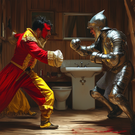乧
乧 character breakdown
second of the ten Heavenly Stems 十天干[shi2 tian1 gan1] / second in order / letter "B" or Roman "II" in list "A, B, C", or "I, II, III" etc / second party (in legal contract, usually 乙方[yi3 fang1], as opposed to 甲方[jia3 fang1]) / ethyl / bent / winding / radical in Chinese characters (Kangxi radical 5) / ancient Chinese compass point: 105°
Who's second always gets a silver medal.
Maud Younger is proudly holding her silver medal in the camera.
The character 乙 actually looks like the character 2.
dry measure for grain equal to ten 升[sheng1] or one-tenth of a 石[dan4] / decaliter / peck / cup or dipper shaped object / old variant of 陡[dou3]
to fight / to struggle / to condemn / to censure / to contend / to put together / coming together
斗
=
⺀
+
十
:
Mnemonic symbol: a 斗牛士 (dou4 niu2 shi4) is a matador, who will represent 斗 when used as component.
The matador (斗) and Don Quixote (d) are fighting (斗) in the outhouse's bathroom (ou4) about who may use the bathroom next. The matador yields a holy cross (十) as a weapon, while Don Quixote (d) wisely chose a blossom (⺀) to cushion the crosses' blows.
The matador (斗) and Don Quixote (d) are fighting (斗) in the outhouse's bathroom (ou4) about who may use the bathroom next. The matador yields a holy cross (十) as a weapon, while Don Quixote (d) wisely chose a blossom (⺀) to cushion the crosses' blows.
Characters with 乧 as component
乧
is not used as a component in another character.
Words with 乧
乧
is not used as a component in another word.
Sentences with 乧
乧 currently does not appear in any sentence.


